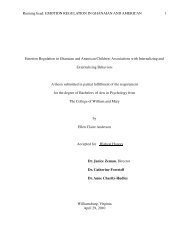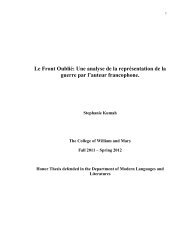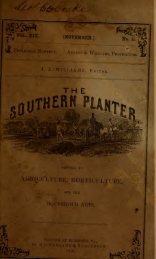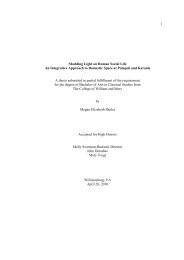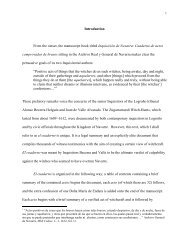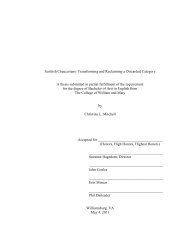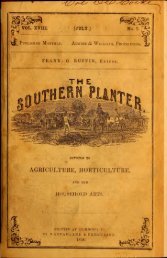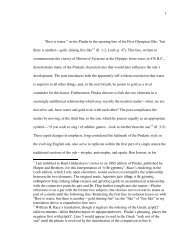Southern planter - The W&M Digital Archive
Southern planter - The W&M Digital Archive
Southern planter - The W&M Digital Archive
You also want an ePaper? Increase the reach of your titles
YUMPU automatically turns print PDFs into web optimized ePapers that Google loves.
1859.] THE SOUTHERN PLANTER. 423<br />
lichen—the same rock crushed into coarse<br />
to fifty years in unbroken succession ; the<br />
ingreaients of these soils being, by chemi-<br />
cal analysis, the same. At present no dif-<br />
ference is known between them, except the<br />
coarseness of the particles, ; the first being<br />
coarse, while the Ohio sand is an exceed-<br />
ingly fine powder. <strong>The</strong> power of soils to<br />
attract and imbibe moisture and oxygen,<br />
was well shown by Sehubler, and Hoffen,<br />
forty years ago. Of thirteen different<br />
soils, quartz sand absorbed in thirty days<br />
over 1-1000 parts of oxygen and no moisture,<br />
while humus absorbed 13 of oxygen<br />
and 120 of moisture."<br />
<strong>The</strong>re is a piece of land, embracing sixty<br />
or eighty acres, within three miles of where<br />
we now write of the character of the fine<br />
sandy land of Ohio, as referred to by Professor<br />
Johnson. While in pursuit of land<br />
some years ago, we became acquainted with<br />
this piece, and from a knowledge of the<br />
character of the sandy land in some of the<br />
Eastern States, we were induced to place a<br />
very low estimate upon our neighbor's land.<br />
This land has since been sold and converted<br />
into a vegetable and fruit farm, and has<br />
proved to be one of the most sure and productive<br />
pieces of land with which we are<br />
acquainted. Of course, it is extremely<br />
warm and brings to maturity vegetables and<br />
fruit, some days earlier than any other land<br />
in the neighbourhood of the city ; and for<br />
the growth of grapes, the fruit is almost in-<br />
variably sound, while that grown in any other<br />
character of soil is subject to rot ; and the<br />
capacity of this soil to retain moisture, is<br />
not surpassed by any other soil combining<br />
any portion of loam that we have seen.<br />
Probably the great secret of the fertility of<br />
this soil, lies in its capacity to absorb and<br />
retain heat, moisture and various gases es-<br />
sential to vegetable growth ; and this is in<br />
consequence of the finely divided character<br />
of its particles, which renders it one of the<br />
most perfect and desirable soils to culti-<br />
grains, grows a much higher order of vegevate.table— pulverized fine, the cereals grow in<br />
Last summer, while exploring certain<br />
it. Geology, chemistry, botany, physiolo-<br />
portions of Long Island, in the State of<br />
gy, meteorology, mechanics, hydrodynamics,<br />
New York, which is noted for its light,<br />
heat, light and electricity, are all intimately<br />
sandy and gravelly soil, we visited a gentle-<br />
combined in the grand process of vegetation.<br />
marA garden and nursery, to witness the<br />
<strong>The</strong>re are sandy soils in our Eastern States.<br />
effect of trenching a light, open, porous<br />
which, without manure, yield meagre crops I<br />
soil— purely sand, coarse gravel and stones,<br />
of rye and buckwheat ; but there are sandy I<br />
with a thin surface soil. This ground had<br />
soils in Ohio, which without manure, yield<br />
| been trenched, and entirely inverted to the<br />
on an average, eighty bushels of Indian <<br />
depth of three and a half feet. Upon the<br />
corn an acre, and have yielded it for twenty 3<br />
surface a moderate dressing of manure had<br />
been cast and spaded in. On the trenched<br />
portion were growing various nursery plants,<br />
grape-vines, roses, &c, of great luxuriance;<br />
but the most remarkable feature was a few<br />
rows of cabbage, upon the same prepared<br />
ground, no head of which was less than ten<br />
inches in diameter, up to a much larger<br />
size, all firm and solid, while in the adjoin-<br />
ing rows, planted the same time upon precisely<br />
the same soil, manured in the same<br />
manner, and spaded to the ordinary depth,<br />
but not trenched, not one cabbage had<br />
headed, but still remained large, loose plants.<br />
In another fruit garden and vineyard of<br />
some magnitude, a mile distant, upon simi-<br />
lar soil, but more sandy and less gravelly,<br />
resting upon a kind of marl or hard-pan<br />
bottom four feet below the surface, this<br />
ground had been trenched in a similar<br />
manner, with an incorporation of a compost<br />
of peat, stable manure, lime, ashes, &c; and<br />
during three months' travel among gardens,<br />
we saw no more vigorous grape-vines, dwarf<br />
pear trees, or other fruit-trees, even upon<br />
the richest soils of Western New York.<br />
We had supposed that trenching such<br />
light thin soils, was worse than labor lost.<br />
But these instances prove to the contrary,<br />
and afford conclusive evidence that without<br />
this preparation of that kind of soil, gardening<br />
and fruit growing would not pay the<br />
cost. It also establishes the most important<br />
fact in agriculture, that the more perfectly<br />
the mechanical disintegration of the soil is<br />
effected, whether light or heavy, the more<br />
perfectly it is adapted to vegetable growth j<br />
and if such results are the effects of the<br />
deep culture of light soils, how much more<br />
important is it that more tenacious soils be<br />
deeply and thoroughly pulverized ! <strong>The</strong><br />
more perfect and free the circulation of<br />
heat, moisture, and the atmosphere, and<br />
gases in the surface soil, and in contact with




